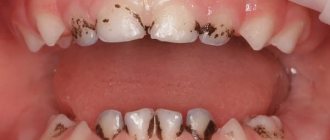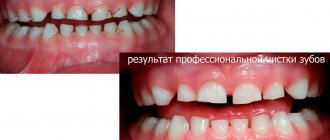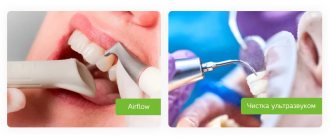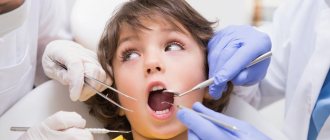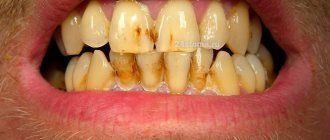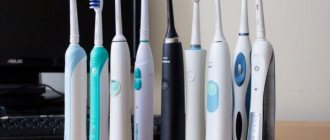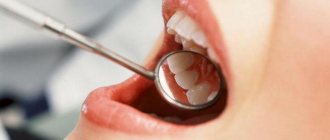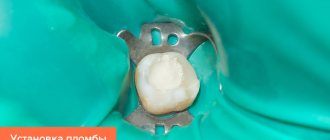Author of the article:
Soldatova Lyudmila Nikolaevna
Candidate of Medical Sciences, Professor of the Department of Clinical Dentistry of the St. Petersburg Medical and Social Institute, Chief Physician of the Alfa-Dent Dental Clinic, St. Petersburg
Cigarette plaque on teeth is an extremely unpleasant consequence of active smoking. It gradually accumulates on the enamel, causing its color to change.
When you abuse tobacco, your smile takes on a pronounced yellow or even dark brown tint, and unsightly stains appear on your teeth that cannot be removed with a brush.
The change in enamel color is a consequence of exposure to substances that are part of smoke, such as nicotine, phenolic and ammonia compounds, and tar. All of them firmly settle on the porous surface of the teeth, penetrating deeper and deeper over time, which leads to the fact that the yellowness becomes more and more pronounced.
The worse a smoker cares about oral health, the faster plaque forms, which ultimately leads not only to aesthetic problems, but also to deterioration in the quality of enamel.
If measures are not taken in a timely manner, the yellow plaque turns into gray-brown. This leads to inflammation of the gums and impaired blood circulation in them. Bleeding, periodontal disease, caries and tartar may occur. Further, the smoker may experience tooth loss, so it is worth paying attention and addressing the problem in a timely manner.
How does smoking affect teeth?
Smoking is a bad habit that negatively affects the overall condition of the oral cavity and dental health. When regularly exposed to tobacco smoke, they acquire a yellow coating and look unattractive. The reason for this is the harmful substances that are part of the smoke - ammonia, tar, nicotine, tar, phenol-formaldehyde, etc. There are about 3,000 substances in total, some of which settle on the enamel and form a characteristic plaque from cigarettes.
Smokers who take good care of their mouths and brush their teeth thoroughly have little plaque buildup. But they also cannot get rid of old deposits that form in hard-to-reach places. Sooner or later, they cease to be just a cosmetic problem and become the cause of dental pathologies.
Absolutely every smoker experiences xerostomia - a kind of dry mouth, indicating an insufficient amount of saliva, which causes a disruption in the natural protective functions of the oral cavity. The result is that plaque very quickly forms on the surface of the teeth, which serves as a breeding ground for pathogenic microorganisms, the waste products of which provoke the appearance of caries and gingivitis.
If a person cannot give up his addiction, then he should regularly remove the plaque that has formed on his teeth from smoking. Otherwise, the development of complications cannot be avoided.
Clinical trials
Clinical studies have proven that regular use of professional toothpaste ASEPTA COFFEE AND TOBACCO for a month improved the hydration of the mucous membrane by 3.3 times, the remineralizing efficiency increased by 3.9 times, at the same time, the cleansing effect has increasing dynamics and reaches 60 .5% at 4 weeks of use.
Sources:
- Report on determining/confirming the preventive properties of toothpaste “ASEPTA PLUS” COFFEE and TOBACCO Author: doctor-researcher A.A. Leontyev, head Department of Preventive Dentistry, Doctor of Medical Sciences, Professor S.B. Ulitovsky. First St. Petersburg State Medical University named after. acad. I.P. Pavlova, Department of Preventive Dentistry
- Report on determining/confirming the preventive properties of toothpaste “ASEPTA PLUS” GENTLE WHITENING” Author: doctor-researcher A.A. Leontyev, head Department of Preventive Dentistry, Doctor of Medical Sciences, Professor S.B. Ulitovsky First St. Petersburg State Medical University named after. acad. I.P. Pavlova, Department of Preventive Dentistry
- Clinical and laboratory assessment of the influence of domestic therapeutic and prophylactic toothpaste based on plant extracts on the condition of the oral cavity in patients with simple marginal gingivitis. Doctor of Medical Sciences, Professor Elovikova T.M.1, Candidate of Chemical Sciences, Associate Professor Ermishina E.Yu. 2, Doctor of Technical Sciences Associate Professor Belokonova N.A. 2 Department of Therapeutic Dentistry USMU1, Department of General Chemistry USMU2
- Report on the determination/confirmation of the preventive properties of personal oral hygiene products “ASEPTA PLUS” Remineralization doctor-researcher A.A. Leontyev, head Department of Preventive Dentistry, Doctor of Medical Sciences, Professor S.B. Ulitovsky First St. Petersburg State Medical University named after. acad. I.P. Pavlova, Department of Preventive Dentistry
- Clinical studies of antisensitive toothpaste “Asepta Sensitive” (A.A. Leontyev, O.V. Kalinina, S.B. Ulitovsky) A.A. LEONTIEV, dentist O.V. KALININA, dentist S.B. ULITOVSKY, Doctor of Medical Sciences, Prof. Department of Therapeutic Dentistry, St. Petersburg State Medical University named after. acad. I.P. Pavlova
- The role of anti-inflammatory rinse in the treatment of periodontal diseases (L.Yu. Orekhova, A.A. Leontyev, S.B. Ulitovsky) L.Yu. OREKHOVA, Doctor of Medical Sciences, Prof., Head of Department; A.A. LEONTIEV, dentist; S.B. ULITOVSKY, Doctor of Medical Sciences, Prof. Department of Therapeutic Dentistry of St. Petersburg State Medical University named after. acad. I. P. Pavlova
Signs of a smoker's plaque
Signs of this unpleasant phenomenon are visible to the naked eye. If desired, every smoker can detect them. To do this, just carefully examine your mouth and teeth in front of the mirror. In this case, the following symptoms of the problem may be observed.
- Visible change in enamel color towards darkening.
- The presence of yellow, brown or black plaque on the neck of the tooth (at the base) or on the inside of the dentition.
- Uncharacteristic color of gums, which look a little “overdried.”
After detecting these signs, all that remains is to exhale sharply into your palm to feel the bad breath - the eternal companion of heavy smokers.
The presence of one or more signs of cigarette plaque is a serious reason to contact specialized specialists - dentists.
Methods of teeth whitening in dentistry
There are several types of professional dental teeth whitening. Your doctor can advise you on the most effective method.
Mechanical bleaching
This method is the most accessible and simple. To clean the enamel, dental attachments are used, with the help of which plaque and stones are effectively removed. After the procedure, the doctor applies a gel to the teeth that protects the enamel.
Chemical procedure
The method is gentle. After it, the teeth become lighter by just a few shades. The gums are covered with a latex protective sheet, after which a concentrated whitening solution is applied to the teeth. The procedure will not apply if the patient has veneers, crowns or fillings.
Photobleaching
The procedure allows you to whiten your teeth by 7-8 tones. The doctor applies the whitening gel and shines a lamp on it. The procedure lasts from 15 to 45 minutes. After the procedure, the doctor applies a product with a high fluoride content to reduce tooth sensitivity.
Professional teeth cleaning from plaque
At the Dental Center on Shabolovka, professional teeth cleaning is carried out to effectively remove smoker’s plaque. To do this, one of the modern methods of teeth cleaning can be used.
- Mechanical cleaning
- the procedure is carried out manually, using ultrasound or Air-Flow and is reduced to the mechanical destruction of plaque and stone. - Chemical cleaning
is a procedure that involves the application of special dental solutions that soften and break down plaque and tartar, allowing them to be removed from the surface of the teeth. - A combined method
is a procedure that includes chemical and mechanical cleaning of teeth, thanks to which you can achieve the best visible result.
Once the smoker's plaque has been removed, the dentist will grind and polish the surface of the teeth, which will significantly reduce the rate at which the problem reappears.
Important to remember!
The popular teeth whitening procedure is carried out only after professional cleaning.
Do-it-yourself whitening
Since it is necessary to constantly visit the dentist to remove plaque, smokers are trying to find ways to whiten their teeth on their own. Methods that can be found on the Internet can be dangerous, but more often they are simply useless:
- Whitening on your own will not remove plaque between your teeth.
- It is impossible to clean the fissures and grooves in the chewing teeth with a toothbrush and improvised means.
- The gingival area of the tooth also cannot be cleaned without dental instruments.
None of the self-whitening methods will remove plaque trapped in microcracks in the enamel.
Professional dental hygiene can help a smoker. The procedure does not whiten the enamel to ideal levels, but it does remove surface pigments. Hygiene is mandatory before the whitening procedure.
Removing smoker's plaque at home
Most smokers are confident that they can get rid of yellow plaque on their teeth without visiting a dentist. To do this, it is enough to purchase one of the “newfangled” whitening products or a special toothpaste. At the same time, they completely do not take into account the peculiarities of the use of these funds and their conditionally positive effect.
The problem is that all home teeth whitening products are effective only in cases of minor plaque and have no effect on old deposits, especially if they are located in hard-to-reach places. Ideally, they should be used after professional cleaning to maintain the achieved result. This must be done with great care, since the active components and abrasive substances they contain have a destructive effect on tooth enamel.
How to clean your tongue
Do not use regular toothbrushes for cleaning - they will not be able to remove plaque. It is better to pay attention to special tongue cleaning products.
Scrapers
The most common devices are scrapers. The tips of the scrapers are made in the shape of a spoon. They are usually made of plastic, sometimes with stiff bristles. The flat shape prevents the gag reflex that may occur when brushing the root of the tongue. This scraper needs to be changed every six months.
Irrigator attachments
Tongue attachments are also made in the form of a spoon. The irrigator, unlike a conventional scraper, delivers a stream of water, which additionally washes the surface of the tongue.
Attachments for electric brushes
Most brush manufacturers offer special attachments for their products to clean tongue deposits. As a rule, they have a flat, textured rubber surface.
Tongue gels
You should not clean your tongue with toothpaste - it is intended for teeth. Pastes contain abrasives and menthol, they can irritate the mucous membrane. Special gels that gently dissolve plaque and also disinfect the oral cavity are better suited for the tongue.
Removing plaque using folk remedies
Traditional medicine does not stand aside from dental problems. And to eliminate smoker’s plaque, she suggests using the well-known baking soda. To do this, you need to mix it with tooth powder or toothpaste and clean your teeth very thoroughly with this mixture. But it must be taken into account that this mixture can be used no more than 2 times a week, which is clearly not enough to remove cigarette stains. Otherwise, baking soda will gradually soften tooth enamel and negatively affect the condition of your gums. Often after such an “execution” there appears profuse bleeding of the gums and increased sensitivity of the enamel, which begins to react painfully to “cold” and “hot”.
There is also a safer method of traditional medicine that allows you to remove smoker’s plaque. To do this, immediately after smoking a cigarette, you need to chew a slice of lemon, green apple or strawberry for a long time. The fruit acids contained in these products will prevent plaque formation. But at the same time, they have a destructive effect on tooth enamel and cause its gradual thinning. And it is unlikely that any smoker will decide to undertake such a complex “ritual” after each cigarette smoked.
How to remove plaque in the dentist's office?
The dentist has many effective ways to remove plaque from smoking. Many people believe that they need to whiten their teeth right away. But first, the doctor will offer you professional hygiene, which necessarily includes plaque removal using ultrasound or an Air-flow device. It is designed to remove soft microbial plaque and tartar using a mixture of abrasive, oxygen and water. This composition knocks down deposits on the enamel, polishes it and helps prevent the development of caries and other infectious and inflammatory diseases.
And only after the stone has been removed can teeth whitening be carried out. This will be the final stage of getting rid of yellow or brown plaque, which is particularly corrosive.
There are several ways to professionally whiten teeth while smoking:
- the use of laser systems to lighten enamel;
- trays with whitening gel for office and home use;
- ZOOM teeth whitening using a special gel and LED lamp.
You can consolidate the result with the help of professional whitening pastes. In the first days after enamel lightening, it is prohibited to consume coloring foods and drinks: coffee, strong tea, wine, beets, sweet carbonated drinks.
It is also recommended to pay increased attention to the quality of personal hygiene. If you brush your teeth poorly, neglect flossing, irrigators, and rinses, then if you smoke, the whitening effect will last only for a few months.
Methods for whitening teeth while smoking at home
If you are unable or unwilling to visit a dentist, you can get rid of plaque from smoking using home methods. But their effectiveness is much lower than professional methods of whitening and removing plaque.
Basic rules and methods for removing smoker’s plaque from teeth:
- If the enamel color is yellow or brown, but there is no solid stone, you can use special home systems to lighten the enamel. They must be applied with a brush or placed in a tray. They decompose the coloring pigment. But if used incorrectly, they can cause irritation of the gums and increased sensitivity of the enamel.
- As an alternative to whitening trays, lightening strips are used. Most often they are used to whiten teeth that are part of the smile area.
- A proven and affordable option for gradually lightening enamel is brushing your teeth with soda. It acts as a soft abrasive and removes not only microbial film, but also dense plaque. Baking soda can be added to toothpaste or used in its pure form. The duration of such bleaching is no more than 7-17 days (no more than 2-3 times a week). If tooth sensitivity increases while using baking soda, you should stop using it.
- Teeth whitening with lemon juice. This method is quite aggressive, as it causes increased sensitivity of the enamel in many people. Lemon juice is applied to the brush with toothpaste in a small amount.
- Use of activated carbon. The method is effective for minor yellowing of the enamel. Activated carbon needs to be turned into powder and used to brush your teeth.
- Use of hydrogen peroxide. The product can be used as a home antiseptic. Peroxide contains atomic oxygen, which effectively destroys pathogenic microorganisms and suppresses the growth of unhealthy microflora.
- Removing plaque after smoking with tea tree oil. It has antiseptic and light whitening properties. Tea tree oil does not irritate the oral mucosa and has a negative effect on cariogenic microorganisms.
To reduce the rate of plaque formation when smoking, it is recommended to brush your teeth or use mouthwash immediately after smoking a cigarette. This will remove most of the tar and nicotine that form the corrosive yellow and brown plaque on the teeth.
Detailed description of teeth whitening with soda
To whiten your teeth by smoking you will need a small amount of baking soda, toothpaste, a toothbrush and some water. You can use several options for lightening the enamel. The first of them involves treating the teeth with a damp brush and dry soda. The second option requires you to first wet the brush and mix baking soda with a small amount of water to a paste-like mixture. This composition is what you need to brush your teeth with.
Contraindications for home enamel lightening using soda:
- increased sensitivity of teeth;
- bleeding gums;
- pronounced carious process;
- exacerbation of any infectious and inflammatory diseases of the oral cavity;
- enamel hypoplasia.
Baking soda can be used to maintain the whitening effect after professional dental procedures. But remember the contraindications and the importance of taking breaks in use. You should not brush your teeth with baking soda every day because of the risk of damaging your teeth and causing inflammation of your gums.
Prevention
If the predisposing factors are not eliminated and the quality of oral care is not improved, plaque from smoking will form again and again. Prevention should be regular. At the initial stage, plaque is soft and can be easily removed with a toothbrush and paste. But over time, it hardens and turns into stone, which cannot be removed at home. The more plaque there is, the higher the risk of developing caries and other dental diseases.
Try to reduce the number of cigarettes you smoke.
You can completely give up a bad habit only gradually, after realizing the harmful effects of smoking on the body. If you have complaints about your oral health, contact your dentist in a timely manner and treat any identified pathologies. This will allow you to keep your teeth beautiful for a long time without resorting to prosthetics and implantation. To get a consultation
The danger of untimely treatment and plaque removal
The appearance of cigarette residue cannot be ignored! Especially if it is accompanied by gingivitis, bad breath and bleeding gums. Failure to promptly seek help and remove plaque will lead to the progression of gingivitis, which will cause periodontal disease - periodontitis. In turn, periodontitis is accompanied by mobility of the dentition, which can ultimately result in tooth loss.
We should not forget about such a dental problem as caries, the main reason for the development of which is dental plaque. The pathogenic microorganisms that “live” in it, day after day, destroy not only the enamel, but also the hard tissues of the tooth, which will ultimately lead to its loss.
Consequences of smoking
From the first months of smoking, tobacco gradually changes the composition of saliva, dulls the functioning of receptors, and also:
- May cause chronic gum inflammation and soreness.
- Promotes bleeding of oral tissues.
- Gradually destroys the integrity of tooth enamel.
- Can lead to stomatitis, the appearance of ulcers on the cheeks, gums, and tongue.
- Causes an unpleasant odor in the human mouth.
Tobacco smoke also negatively affects the healing process of oral tissues. In this regard, people who smoke have a harder time with dental procedures: fillings fall out more often, and after tooth extraction, the hole will take longer to heal.
Only numbers
- 75% of men and 21% of women in Russia smoke constantly.
- 1-2 packs of cigarettes contain a lethal dose of nicotine. The only thing that saves the smoker is that this dose is not introduced into the body immediately, but in parts.
- The average smoker takes 200 puffs a day. Each time he inhales more than 30 toxic chemical compounds. 25% of regular cigarette smokers will die prematurely due to smoking.
- After 3 months of smoking, a person becomes dependent on tobacco. In women, tobacco addiction develops more rapidly than in men.
Mucous membrane
The influence of tobacco smoke on the mucous membrane of the mouth leads to a disease that remains invisible for a long time, since the smoker does not experience any unpleasant sensations, and the dentist does not always pay attention to the mucous membrane.
We are talking about the so-called smoker's leukoplakia or nicotine leukoplakia of the palate. This is the mucous membrane's response to smoke irritation. When you inhale it, the smoke rises up to the roof of your mouth. Constant exposure to the mucous membrane of the palate leads to changes appearing on it. At first it is just a whitish plaque that can only be noticed during a dental examination. The person does not feel any discomfort or pain. Next, the ducts of the salivary glands expand, which intensively produce the missing saliva. Then dense, bumpy formations appear on the mucous membrane. Its tissue changes, something like warts appears.
The places where leukoplakia has developed are drier, and saliva is retained less on them. In these areas, the mucous membrane does not renew, and then the process of keratinization and compaction begins: thicker cell membranes are formed due to metabolic disorders. If this disease is not treated (and the first stage of such treatment is quitting smoking), cancer may develop. When you stop smoking, even advanced leukoplakia in its final stages goes away.
Your actions. To speed up the healing process, it is useful to take vitamins A and E in tablets or capsules. Oil applications, rinsing the mouth with St. John's wort, calendula, and plantain juice have a beneficial effect on the mucous membrane.
Don't be surprised if you notice that any wounds in your mouth are not healing well. This is also the result of the action of hot smoke, which, when smoking, irritates the mucous membrane and burns it. The chemical components of smoke absorbed into the mucous membrane suppress the formation of the enzyme that disinfects the oral cavity - lysozyme, so that any infection develops more easily. Lysozyme, in addition, is involved in the normal restoration of the mucous membrane, and when smoking this process slows down. At the same time, vitamin A metabolism is disrupted, which also reduces protection. Therefore, taking additional portions of vitamin A is absolutely necessary even for those who smoke a little and do not yet complain about anything.
